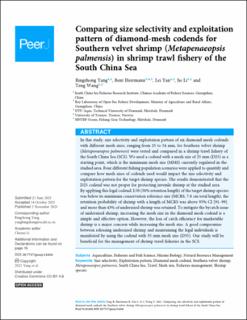| dc.contributor.author | Yang, Bingzhong | |
| dc.contributor.author | Herrmann, Bent | |
| dc.contributor.author | Yan, Lei | |
| dc.contributor.author | Li, Jie | |
| dc.contributor.author | Wang, Teng | |
| dc.date.accessioned | 2022-09-12T08:18:24Z | |
| dc.date.available | 2022-09-12T08:18:24Z | |
| dc.date.created | 2021-11-23T15:44:06Z | |
| dc.date.issued | 2021 | |
| dc.identifier.citation | PeerJ. 2021, 9 . | en_US |
| dc.identifier.issn | 2167-8359 | |
| dc.identifier.uri | https://hdl.handle.net/11250/3017119 | |
| dc.description | Yang B, Herrmann B, Yan L, Li J, Wang T. 2021. Comparing size selectivity and exploitation pattern of
diamond-mesh codends for Southern velvet shrimp (Metapenaeopsis palmensis) in shrimp trawl fishery of the South China Sea.
PeerJ 9:e12436 DOI 10.7717/peerj.12436 | en_US |
| dc.description.abstract | In this study, size selectivity and exploitation pattern of six diamond-mesh codends with different mesh sizes, ranging from 25 to 54 mm, for Southern velvet shrimp (Metapenaeopsis palmensis) were tested and compared in a shrimp trawl fishery of the South China Sea (SCS). We used a codend with a mesh size of 25 mm (D25) as a starting point, which is the minimum mesh size (MMS) currently regulated in the studied area. Four different fishing population scenarios were applied to quantify and compare how mesh sizes of codends used would impact the size selectivity and exploitation pattern for the target shrimp species. The results demonstrated that the D25 codend was not proper for protecting juvenile shrimp at the studied area. By applying this legal codend, L50 (50% retention length) of the target shrimp species was below its minimum conservation reference size (MCRS, 7.0 cm total length), the retention probability of shrimp with a length of MCRS was above 95% CI [91–99] and more than 43% of undersized shrimp was retained. To mitigate the bycatch issue of undersized shrimp, increasing the mesh size in the diamond mesh codend is a simple and effective option. However, the loss of catch efficiency for marketable shrimp is a major concern while increasing the mesh size. A good compromise between releasing undersized shrimp and maintaining the legal individuals is manifested by using the codend with 35 mm mesh size (D35). Our study will be beneficial for the management of shrimp trawl fisheries in the SCS. | en_US |
| dc.language.iso | eng | en_US |
| dc.publisher | PeerJ | en_US |
| dc.rights | Navngivelse 4.0 Internasjonal | * |
| dc.rights.uri | http://creativecommons.org/licenses/by/4.0/deed.no | * |
| dc.subject | Shrimp species | en_US |
| dc.subject | Fisheries management | en_US |
| dc.subject | Mesh size | en_US |
| dc.subject | Trawl | en_US |
| dc.subject | South China Sea | en_US |
| dc.subject | Metapenaeopsis palmensis | en_US |
| dc.subject | Southern velvet shrimp | en_US |
| dc.subject | Diamond mesh codend | en_US |
| dc.subject | Exploitation pattern | en_US |
| dc.subject | Size selectivity | en_US |
| dc.title | Comparing size selectivity and exploitation pattern of diamond-mesh codends for Southern velvet shrimp (Metapenaeopsis palmensis) in shrimp trawl fishery of the South China Sea | en_US |
| dc.type | Peer reviewed | en_US |
| dc.type | Journal article | en_US |
| dc.description.version | publishedVersion | en_US |
| dc.rights.holder | Copyright 2021 Yang et al. | en_US |
| dc.source.pagenumber | 0 | en_US |
| dc.source.volume | 9 | en_US |
| dc.source.journal | PeerJ | en_US |
| dc.identifier.doi | 10.7717/peerj.12436 | |
| dc.identifier.cristin | 1958038 | |
| cristin.ispublished | true | |
| cristin.fulltext | original | |
| cristin.qualitycode | 1 | |

